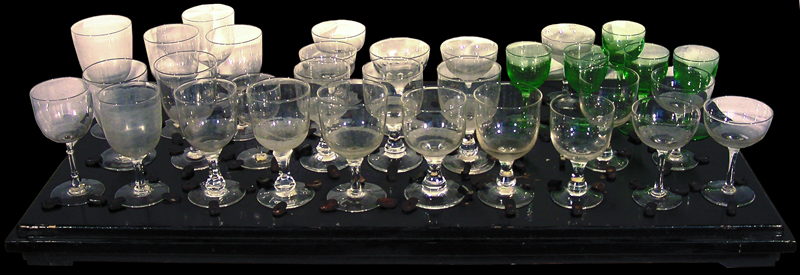 |
 |
| Glass Harmonica, Glass Harp, Musical Glasses - Europe Musical glasses were first illustrated in a 1492 woodcut showing six glasses being struck by small sticks, and then described in a document from 1596 with three and a third octaves. It was not until 1744 that the method of playing glasses by stroking the rims with moistened fingers appeared, attributed to an Irishman, Richard Pockrich. The instrument quickly gained popularity, with Gluck performing concerts on a 26 glass set in 1746 and again in 1749, and the first method book for glass playing being published in 1761 by Ann Ford. In 1761, when Benjamin Franklin heard a performance of musical glasses, he decided to improve the instrument by mounting a series of stacked bowls on a horizontal central spindle so that they could be spun with the use of a treadle. This invention he named the Glass Armonica. With the bowl rims in close proximity the player could easily play chords on the instrument and it quickly gained popularity. In 1791, Mozart wrote Quintet k617 for the aromica, flute, oboe and cello for the popular blind performer Marianne Kirchgessner. The interest in glass instruments lasted until the 1830s, with a small revival again in the latter 20th century. As a result there are now electric versions of the Glass Armonica. The terms glass harmonic or glass harp are now used for the original version made of tuned stemmed wine glasses. The wine glasses are attached to a soundboard in a variety of patterns to assist in playing more than one glass at once. The best-known 20th century performer is Bruno Hoffman who many commercial recording of the glass harp. There were many rumors of the high piercing sounds of the glasses being a cause for insanity and the instrument was not only banned in many cities, but parents still tell their children not to rub the rims of a wine glass or they will go mad. The only truth to this myth probably lies in the incredible stress the performers must have felt in transporting their precious glass instruments over dirt or cobblestone roads in the back of a horse drawn carriage. The instrument shown is over 125 years old and was made in England. Most of the glasses were either made to pitch or ground to pitch. Some replacement glasses are used and need water to tune. Most of the glasses are made from crystal, and are held to the soundboard by small strips of leather. Country: England, Germany |
 Rebab - Rabab |
| © R. Raine-Reusch, May 2002 |